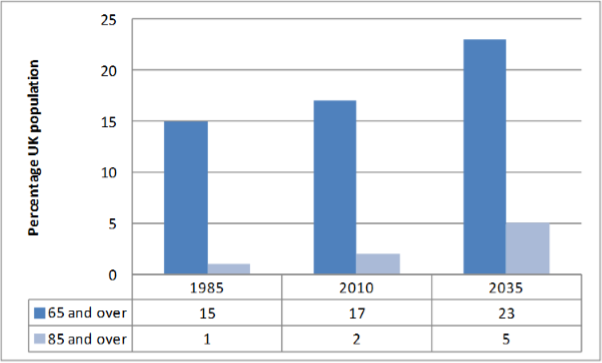Older People: Why is it important to act?
An ageing population means that more people will become vulnerable to climate impacts and extreme weather in the future compared to today.

Credit: JRF/Mike Gibb
On this page:
Managing increasing pressures
Figure 3 shows an exponential growth in both over 65 year olds and over 85 year olds, with the proportion of those over 85 expected to more than double between 2010 and 2035.1 People aged over 65 will form nearly a quarter of the UK population by 2035. Even with no change in the numbers and intensity of extreme events, this means that the impacts from floods and heatwaves are likely to be more severe. The state of health of the ageing population could also exacerbate problems.

Figure 3: Relative proportions of the UK population aged 65 and 85 years and over in 1985, 2010 and 2035 (projected)2
Preparing for extreme weather events can help with effective use of resources and building community resilience.
- Climate projections and analysis show that the frequency of heatwaves is increasing.3 Evidence from the UK Climate Change Risk Assessment (CCRA) suggests that by the 2080s what we currently understand as a heatwave could occur most years and could even occur more than once a year in some regions. However, changes will be felt much earlier than the 2080s. Regional assessments suggest that, on average, heatwave frequency could be six times higher by the 2050s alone.
- The pressures on health services dealing with emergency situations will be much greater. Heatwaves often do not occur in isolation and may be associated with other events such as droughts and wildfires, which have their own health consequences.
- It is also anticipated that the emergency services will face greater pressure from an increasing frequency of floods. Estimates from the CCRA suggest a further 0.9 to 2.3 million people could be at significant risk of river flooding by the 2080s4 requiring more than doubling in the effort of emergency services, without taking account of any change in costs associated with responding to more severe events.5
Duties and responsibilitites
Local authorities and their partners in health and social care have statutory duties and other responsibilities relating to protecting people’s health and this inevitably connects to the needs of older people. For instance:
- The Health and Social Care Act 2012 puts local authorities at the centre of activities to improve health, with public health now brought into local government. This brings together the work of the NHS with those providing social care, housing, environmental health, leisure and transport services. The Act puts new duties on clinical commissioning groups to have regard to the need to reduce inequalities in benefits which can be obtained from health services, including both NHS and public health functions. Important instruments for joining up actions to address climate risks and extreme weather events are the Joint Strategic Needs Assessments (JSNAs) and the associated strategies produced by Health and Wellbeing Boards. Health and Wellbeing Boards also have a duty to encourage health and care commissioners to work together to enhance the health and wellbeing of people in their area.
- The Equality Act 2010 allows for positive action in favour of people in groups with protected characteristics.6 Protected characteristics include disabilities defined as “physical or mental impairment that has a ‘substantial’ and ‘long-term’ negative effect on normal day-to-day tasks.”7 This sits alongside human rights legislation, through the Human Rights Act 2000, which protects rights of fairness, respect, equality, dignity and autonomy for all and which has been used in relation to housing, health and social care for older people, including the residents of care homes.8 However, at present the protection for care home residents is only partial, i.e. only for people placed by local authorities or the NHS.9
- The Civil Contingencies Act 2004 identifies local authorities, along with the emergency services and NHS bodies as the key organisations who have a responsibility for developing plans for emergencies. They need to work with other organisations in local resilience fora to develop responses to support civil protection.
- The Heatwave Plan for England is non-statutory but provides a basis through which other obligations to produce adaptation plans can be developed. Its main purpose is to provide information which helps in the process of building more resilient communities to heatwaves. It sets out ways to prepare for heatwave events and what to do to avoid some of the most severe impacts from prolonged exposure to high temperatures. Raising awareness among the wider public is one important goal. It also highlights the role of local NHS, public health and social care organisations in overseeing the care of people with particular susceptibilities, to help reduce the potential for over-exposure and to help ensure that service provision is sufficiently resilient to cope with the challenges associated with heatwaves.
Older people need to be central to adaptation planning as a group who can be expected to face disproportionate impacts on health and wellbeing.10,11 However, a blanket response for all older people is not likely to be effective since this may miss individuals who are most vulnerable and have the greatest needs due to a combination of personal, social and environmental factors, such as those associated with illness, income, poor mobility, lack of social ties and maladapted living accommodation.
Most of the impacts of floods and heatwaves on older people are preventable. There are personal and community actions which can help to ensure that older people are better prepared for emergency situations. Awareness raising and simple practical measures can help to avoid impacts and aid with the recovery process. It could also help to make neighbourhoods more ‘age-friendly’ and communities more supportive of the needs of people living with the declining mental ability associated with some forms of dementia.12 If a locality is more inclusive and supportive it is less likely that people will be left on their own to face an emergency.
References
- ONS (2012) Population Ageing in the United Kingdom, its Constituent Countries and the European Union
- ONS (2012) Population Ageing in the United Kingdom, its Constituent Countries and the European Union
- Defra (2012) UK Climate Change Risk Assessment: Evidence Report, London
- According to the central estimate associated with the medium emissions scenario in the CCRA
- Defra (2012) UK Climate Change Risk Assessment: Evidence Report, London
- GOV.UK website Discrimination, know your rights
- GOV.UK website Definition of disability under Equality Act 2010
- British Institute of Human Rights (2010) Your Human Rights. A guide for older people Second edition
- Community Care website article about Age UK's criticism of Government plans regarding the Human Rights Act
- Public Health England. 2013. The heat-wave plan for England 2013.
- Vardoulakis S & Heaviside C (2012), Health Effects of Climate Change in the UK 2012. Health Protection Agency
- Innovations in Dementia (2011) Dementia Capable Communities. The views of people with dementia and their supporters, February 2011

Built by:

© 2014 - Climate Just
Contact us
